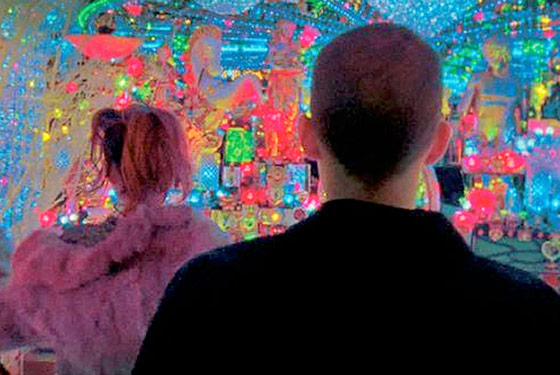
With Enter the Void, Gaspar No├® continues to earn his position as the cinemaÔÇÖs most bombastic visionary, a director who wears you down with the brutality, sensory overload, and sheer length of scenes that other artists (those wusses!) execute swiftly and move on. Most notorious was the nine-minute anal rape and pummeling of Monica Bellucci in Irreversible, shot in real time with a single stationary camera. No├® wanted to do to the audience what deprogrammers did to Alex in A Clockwork Orange: drive home his moralism by making us retch. At least in his new film, there are no protracted buggerings ÔÇö unless you count the reaming of the audience.
Enter the Void is, admittedly, a trip unlike any other, the hallucinatory odyssey of a young American drug dealer, Oscar (Nathaniel Brown), gunned down by Japanese cops in the menÔÇÖs room of a club called ÔÇö wait for it ÔÇö the Void. The film is shot from OscarÔÇÖs point of view (we only glimpse his face in mirrors), his postmortem journey both spatial ÔÇö moving through the city, looking straight down on its neon-lit streets ÔÇö and temporal ÔÇö drifting back in time to the decisive moments of his life. There are romps on the beach with his parents and little blonde sister, Linda. Then theyÔÇÖre in a car, smiling and laughing, and this being No├®, you know before it happens that a truck is going to smash through the windshield and splatter Mom and Dad over their childrenÔÇÖs faces. No├® loves the sight of that little girl shrieking, ÔÇ£Mommy! Mommy! Daddy!ÔÇØ as rescuers pull her from the car; he keeps coming back to the scene, the shrieks louder, as if it werenÔÇÖt unspeakable enough the first time.
Did you ever wonder what it would be like to be strapped in front of a strobe light for two and a quarter hours? Enter the Void and wonder no more. The light flickers incessantly; the soundtrack hums and crackles like a shortwave radio; there are snatches of music and fuzzy murmurs. No├® wants to induce a drug state, but this is no kaleidoscopic Peter Fonda wig-out. Oscar has been poring over the Tibetan Book of the Dead, so what weÔÇÖre watching is supposed to be the migration of his soul ÔÇö a letting-go of his desolate sister (Paz de la Huerta), a merging into the cosmic soup. IÔÇÖm not speaking in metaphor. Where Stanley Kubrick in 2001 gave us mankind reborn as a baby in an astral bubble, No├® takes twenty times as long to shoot conception: His camera hovers over loveless sex ÔÇö over fucking, sucking naked bodies ÔÇö then burrows into a womanÔÇÖs vagina and follows the wriggling sperm until they reach the egg. One pushes, pushes, pushes, aaaaaaaand itÔÇÖs in! If you put on ÔÇ£Thus Spake Zarathustra,ÔÇØ youÔÇÖd have the ultimate campy party movie.
Reportedly, No├® trimmed some longueurs after a divisive screening at Cannes, but whatÔÇÖs left is almost all longueurs. What did he trim? A fifth scene of the little girl wailing over the bloody corpses of her parents? More unappetizing loveless couplings bathed in red? DirectorÔÇÖs cut!


